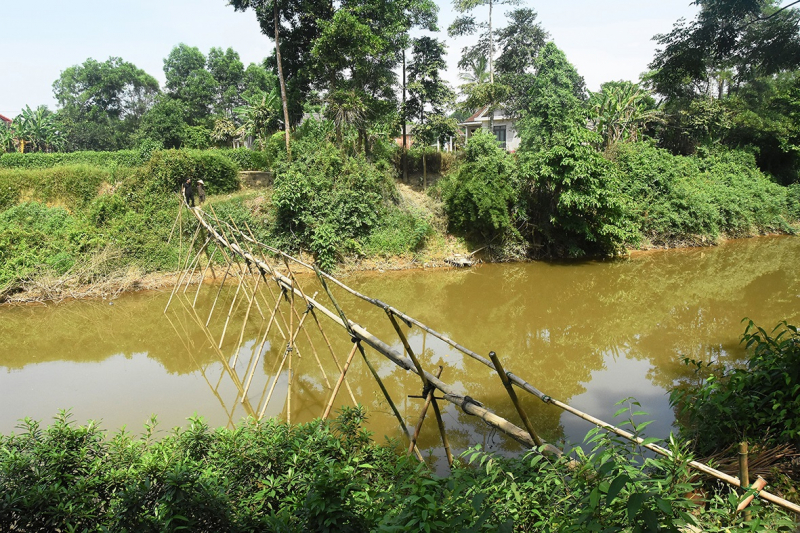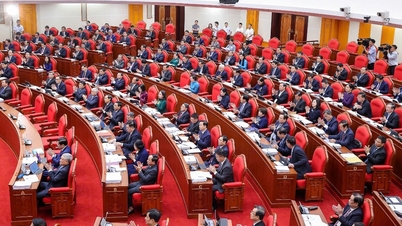Locals still call it the "community bridge," but in reality, it's a bridge of patience and resilience, where generations have sacrificed their safety to maintain the rhythm of life on both banks.

In the sweltering midday heat of summer, despite being over eighty years old, Mrs. Ho Thi Thu quietly sat by the bridge to enjoy the cool breeze. Her hair was as white as ash, but her eyes still shone with nostalgia as she recalled the early days when the villagers themselves contributed bamboo, wood, and labor to build the bridge across the river. “After liberation, everyone was poor, but we couldn’t let the river separate us forever. So the men and young people cut bamboo, the women took care of the cooking and water, and that’s how we built the first bridge…” Her voice trembled, like a flood of memories.
Over the past fifty years, the Nhung River has changed course, eroding and widening the riverbed, and the bamboo bridge has grown longer and longer, sometimes reaching seventy or eighty meters to connect the two banks. Yet the bridge remains… a bamboo bridge. No sturdy railings, no concrete foundations, just hastily joined bamboo poles, tightly bound with ropes, enduring sun, rain, floods, storms, and even the trembling footsteps of the elderly and children.
Mr. Nguyen Cuoi, a man in his fifties working as a construction worker, crossed the bridge every day to get to his work on the other side of the river. Once, during the July flood season, he slipped and fell halfway across the bridge, amidst the pitch-black darkness and the rushing sound of the water. “Luckily, I managed to grab onto a clump of bamboo near the bank; my survival is thanks to the blessings of my ancestors,” he said, his voice trembling as he clutched his faded helmet.
But not everyone is as lucky as Mr. Cuoi. A few years ago, a boy of about eight or nine years old, visiting his grandfather in Rao hamlet, slipped and fell into the fast-flowing water while crossing the bridge and never returned… Tragedy struck, like a warning bell about the lurking danger. Yet, people still continue to cross the bridge, because it is the shortest and only route connecting production, daily life, and family ties.
Mr. Cuoi's family, like dozens of other households in the area, owns farmland on both sides of the Nhung River. Each harvest season, transporting fertilizer, machinery, and harvesting rice requires a roundabout route through another commune before reaching home, a distance of up to ten kilometers, instead of just one kilometer if they could cross the bamboo bridge. "Sometimes I can see my house on the other side, but I have to transport the rice around in circles, wasting fuel and effort, and it's even worse when it rains or is windy," he lamented.
Sadly, that fragile bridge is swept away several times a year during the flood season. In September and October, the floods come, and the bridge is carried away by the current. Around Tet (Lunar New Year), the villagers get together to rebuild it. In February and March, if there are heavy rains, the bridge is swept away again. The people here are used to the cycle of being swept away and then rebuilt, a sad pattern of fate. The cost of rebuilding the bridge each time isn't high, around 3 to 4 million dong, but the effort and worry involved are immeasurable. The old bridge, rebuilt at the end of 2024, has bamboo sprouting again before it even dries, a symbol of silent rebirth.
Mr. Hoang Viet Ha, who lives right at the beginning of the bridge, has witnessed countless instances of people falling from the bridge, plunging into the river, and even dying. “This bridge is a lifeline. If it washes away, we rebuild it, but sometimes we can’t rebuild it in time, and the whole neighborhood becomes an isolated island. Children can’t get to school, the sick can’t cross, and production comes to a standstill…”, he said, gazing at the flowing water thoughtfully.
Rao Hamlet and Phuoc Hamlet, two small residential clusters in Team 3, Mai Dan Village, comprise a total of over 110 households. All of them depend on the farmland on both banks of the Nhung River for their livelihood. Without a bridge, farming is impossible, access to school and market is impossible, and timely medical care for the sick is also impossible. The simple bamboo bridge has served its purpose of connecting them for many years, but it's time to replace it with a sturdy bridge, not only for people to cross, but also to give them peace of mind to live, produce, and build their lives.
Ms. Ho Thi Thu An, head of Mai Dan village, said with concern: “The villagers can contribute their labor and bamboo to rebuild the bridge, but they cannot build a sturdy bridge themselves. We earnestly hope that the State will pay attention and invest in building a solid bridge for the people, to help hundreds of villagers escape the hardship of wading through water, trembling on bamboo poles, and constantly fearing accidents…”
The time has come when the small bamboo bridge in the countryside will no longer be a symbol of uncertainty and hardship, but a beautiful memory – replaced by a new, sturdy bridge connecting the lives of people on both banks of the Nhung River. A bridge that not only connects the land, but also connects the hearts of the people with faith in genuine care from those in charge…
Source: https://cand.com.vn/doi-song/chiec-cau-tre-va-uoc-mo-noi-doi-bo-song-nhung-i768985/









































































































Comment (0)